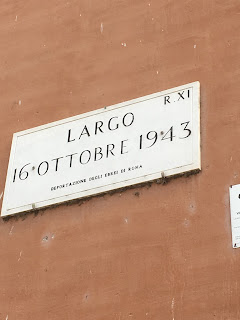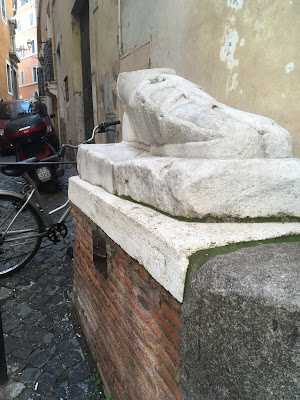Do you know? Did some developer get a little wild about Robin Hood, and so you have Maid Marian Street, Sherwood Lane, and Friar Tuck Circle? Or was someone a bit unimaginative with their place name choices, like Maple Street, Riverside Drive, or Park Avenue?
Welcome to a city with a deep history, street-wise (and of course, otherwise).
Terminology for streets here are as follows:
Basic Roman street terms (like 'street,' 'avenue' and 'road') are via, viale, corso (<that last one is often a main thoroughfare>) 'Corso' is, I think, often conflated with 'way.'
A "little" street: viccolo
A little street with an arch over it: arco
A wide avenue: largo
A road alongside a body of water: lungotevere
Many Roman streets reflect an ancient or medieval history for the area. The Street of the Bear (Via del'Orso) is so named for this:
Does this look like a bear to you?
I didn't think so.
There are 7 hills of Rome, but there are other little 'mountains' that were actually man-made - at least in theory. So here is the mountain of flour street.
 |
| "wide avenue of the raid of the Roman Jewish ghetto" |
 |
| street of the fish market (which is basically in the ghetto) |
 |
| street of the pasta (or dough, technically) |
 |
| Street of the little pasta or dough makers |
 |
| street of the orphans |
 |
| Street of the coat-makers |
 |
| Street of the hat-makers |
 |
| Little street of the stamp |
 |
| Little street of divine love |
My street is the street of The Renaissance. Do a reverse look-up and then realize that the Renaissance in this case was not the era of the 1500s...it was most likely the 're-birth' of Italy under Fascism.
And in summer? The fruit guy. He's pretty popular.
As you walk the city, you are bound to see some polizia on horseback.
I'm sorry to report (or happy to report, depending on your point of view, I guess) that a very modern McDonalds has opened on my street. *sigh*
What's even better, however, is the fact that a salumi/formaggi (salami and cheese) deli, selling excellent porcini sandwiches, has installed itself to the right of this fast food mecca. And the line of hungry tourists extending out the door of the deli makes me super happy.
So this guy, in pretty warm weather, still sporting a leather jacket, balanced precariously on a chain strung between two posts....watching the crowds walk by....appears as if floating.
Street names here often carry a history of the types of things that occurred on them (whether or not those things still occur), the types of vendors that populated them or some unique feature of art or architecture that exists on them. In a way, the streets record the histories of neighborhoods, the warp and the weft of the city's fabric.
 |
| street of the barbershops |
 |
| street of the sow |
And here is the sow...an ancient relief embedded in an exterior wall. I make sure that I pat her flank every time I walk by. The inscription tells us that in this location was a fountain (the end of a small water pipe is located in the shadow under the sow's mouth) that was then relocated to a street nearby.
To the left side of the brick ruin that projects out from the wall here, you can see a window with its shutters mostly closed. In reality, whoever lives there cannot open that shutter closest to the brick wall. It's too close.
Now.....this one. Allegedly named for a fountain that depicts the she-wolf that nursed Rome's twin founders, Romulus and Remus, as infants...I tend to wonder if it was also a street for prostitution, as 'lupa' is slang for prostitute.
The Street of the Lion is so-named for a disappointingly eroded relief of a lion, I think, seen here.
However, the Urban Dictionary tells me that Leonetti (note the change in vowel at the end) could be slang for...a small, ugly man with a small member.
So technically, this could be the small street for the small man with a small...
Um, yeah.
The Vie dei Pie de Marmo is, as you might imagine, named for a large, ancient marble foot, which probably once belonged to a statue of Isis.
Yeah, it pronates a bit. Fancy sandal, though.
Sometimes, it's not so easy to discern why a street has its name. Street of the melon? I just don't know.
But this one is easy: the famous Neoclassical sculptor Antonio Canova had a studio on this street. It became a space that other ex-pat sculptors later in time used it too: the most interesting of these, for my money, was American sculptor Edmonia Lewis.
Sometimes, you find other things on Roman streets, such as a personal, not-quite-permanent, memorial.
Sometimes, a place is a bucolic ideal.
Or it has an ancient fragment, stuck to a wall with little or no context.
Sure, you notice the debris and even outright trash, but you can still notice a kind of beauty.
Order.
Sloth.
And enduring mystery...or is it mysterious endurance?























No comments:
Post a Comment